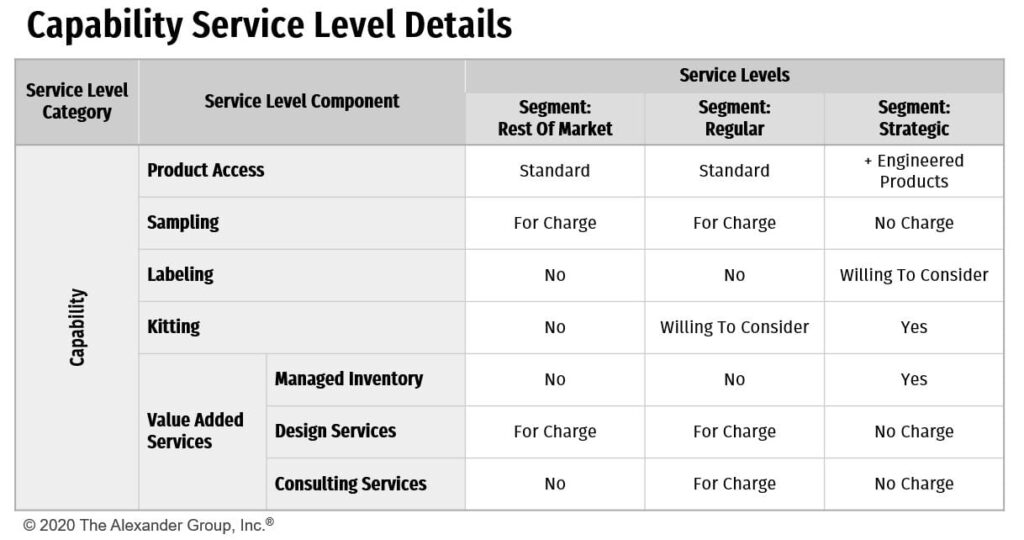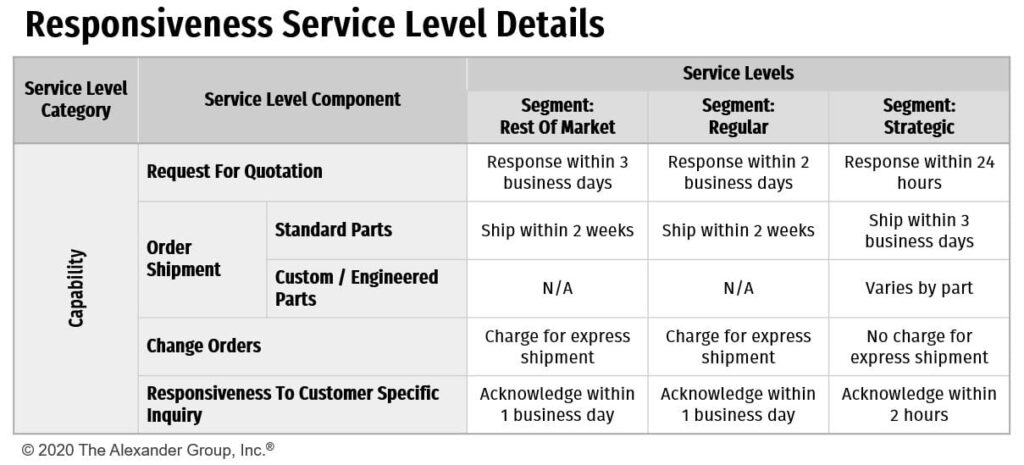Differentiate Service Levels & Grow Margin – Part 2
Successful distributors differentiate commercial service levels (CSLs) based on customer need and value.
In part 1 of this series, we outlined the key inputs to successfully design CSLs for your organization. In this article, we will discuss the first categories of service level components to design: capabilities and responsiveness.
- Part 1: Inputs – gathering opportunity data, voice of customer and other information required to build CSLs
- Part 2: Capabilities & Responsiveness – differentiating product and service offerings, response time, solution customization and lead times
- Part 3: Support – differentiating access to the resources (e.g., sales, marketing, service and support), technology and tools that span the buyer journey
- Part 4: Terms & Pricing – differentiating the payment terms, shipping practices and pricing agreements
In each installment, Alexander Group will share industry trends, project learnings and salient benchmarks. The goal of the series is to encourage distributors to think about the value of specific customers and tailor service levels that balance customer satisfaction and cost to serve.
Part 2: Capabilities & Responsiveness – differentiating product and service offerings, response time, solution customization and lead times
Capabilities
Capability service levels focus on the product and service offerings distributors are able to provide to different customer segments. Differentiated offerings facilitate improved cost management and ensure top customers have access to value-added services or product customization. The capability group includes service levels like Product Access, Sampling, Labeling, Kitting and Value Added Services.
- Product Access: Customer value dictates the combination of products a distributor offers as part of the service level and what products are accessible to the customer. For example, a distributor could offer standard parts to a majority of their customer groups. For their strategic customers, however, they are willing to offer non-standard, engineered or custom parts and are willing to source non-standard products.
- Sampling: A sampling service level component defines the distributor’s willingness to provide samples to their different customer groups. For lower-value customers, that may mean that a distributor offers samples for a charge and with a minimum quantity expectation.
- Labeling: A distributor may be willing to offer custom packaging or labeling for their strategic customers. This can differentiate a distributor from their competition and truly enhance the customer experience.
- Kitting: A distributor may be willing to offer inventory kitting services to strategic customers by creating a unique kit with all components required for their specific application.
- Value Added Services: This service level component details the type of value added services a distributor may provide. This component can include things like managed inventory, design services, consulting services, and safety or risk management services.

Responsiveness
These service levels focus on lead times and types of responses for different steps along the customer engagement process. By differentiating responsiveness throughout the customer engagement process, it allows sales and other functions, like customer support and supply chain, to prioritize their work around the top customers.
- Request for Quotation (RFQ): Differentiating response time to RFQs allows distributors to ensure that the teams involved in putting together pricing and specs can focus on providing the timeliest response to top customers. A distributor may also further differentiate this service level based on whether the RFQ is for standard or custom parts. If the RFQ is for custom parts, as outlined above in “Product Access,” a distributor’s response may be to route some customers to standard parts.
- Order Shipment: Differentiating lead times for order shipment is especially valuable for functions that are involved in fulfilling and shipping orders. It is important that those functions be involved in the design of the service levels to ensure that we have the capabilities to deliver those terms.
- Change Orders: This service level component outlines how a distributor will respond to a customer asking to change ship date or other order details. In some cases, a distributor may be willing to honor all change orders but with differentiated lead times. More often, this service level outlines whether a distributor is willing to accept change orders or not. For their strategic customers, they may be willing to adjust orders or even cancel orders if it was for the greater good of the customer relationship.
- Responsiveness to Customer Specific Inquiry: A distributor wants to ensure all customers have a positive experience but not the same experience. For this component, a distributor can differentiate how quickly they respond to inquiries from customers. Large customers would expect to hear back from their distributor within 24 hours.

To identify and configure the right service level components for different customer segments, successful distributors gather inputs from stakeholders across functions. This will ensure that the distributor defines service levels for areas that would benefit from differentiation and formal documentation.
Next up in this article series, we will explore the service level components that are part of the support category–differentiating access to the resources, technology and tools that span the customer journey.
Do you have questions around commercial service levels at your company? Contact one of Alexander Group’s Distribution practice experts.
You may also be
interested in:
Distributors: Differentiate Service Levels & Grow Margin – Part 1

